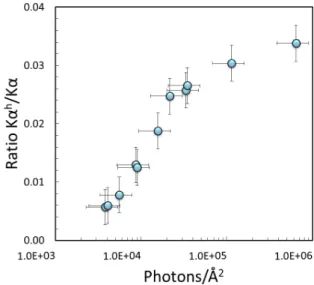X-ray two-photon absorption with high fluence XFEL pulses
J. Hoszowska* 1, J. Szlachetko†a, J.-Cl. Dousse*, W. Błachucki*, Y. Kayser†, Ch. Milne†,M. Pajeka , S. Boutetb, M. Messerschmidtb, G. Williamsb, and C.T. Chantlerc *
Department of Physics, University of Fribourg, CH-1700 Fribourg, Switzerland
†
Paul Scherrer Institut, CH-5232 Villigen PSI, Switzerland
a Institute of Physics, Jan Kochanowski University, 25-406 Kielce, Poland
b Linac Coherent Light Source (LCLS), SLAC National Accelerator Laboratory, 94025 California, USA c
School of Physics, University of Melbourne, Parkville, Victoria 3010, Australia
Synopsis. We report on nonlinear interaction of solid Fe with intense femtosecond hard x-ray free-electron laser (XFEL) pulses. The experiment was performed at the CXI end-station of the Linac Coherent Light Source (LCLS) by means of high-resolution x-ray emission spectroscopy. The focused x-ray beam provided extreme fluence of~105 photons/Å2. Two-photon absorption leading to K-shell hollow atom formation and to single K-shell ionization of solid Fe was investigated.
X-ray free electron laser (XFEL) facilities, with
unprecedentedly high peak power densities reach-ing ~1020 W/cm2, have paved the way to study non-linear phenomena in the x-ray regime [1-6]. In this work we explored nonlinear interaction of high-fluence hard x-ray femtosecond pulses with solid Fe. Single and double K-shell electron ionization pro-cesses resulting from two-photon absorption were observed.
The experiment was carried out at the CXI end-station of the Linac Coherent Light Source (Menlo Park, USA) XFEL by means of the high energy res-olution x-ray emission technique. The XFEL beam of ~5x1011 x-rays/pulse and pulse energy of 0.6 mJ was focused on a metallic Fe sample. The ultra-focused x-ray beam provided extreme fluence of ~105 photons/Å2. Moving the sample out of the fo-cus along the beam allowed varying the fluence. For the Fe Kα (K-1→L-1) and Kαh (K-2→K-1L-1) ra-diative transitions measurements the bent crystal von Hamos x-ray spectrometer of PSI [7] installed at CXI and equipped with the CSPAD detector de-veloped at SLAC was employed. The K x-ray emis-sion spectra were collected at photon beam energies below the Fe K-shell single- and double-ionization thresholds for the two-photon single ionization and double ionization processes, respectively.
For illustration, the probability of double K-hole formation via sequential absorption of two photons versus x-ray fluence is shown in figure 1. We ob-serve a ~60-fold increase in the production proba-bility of Fe hollow-atoms as compared to single-photon double ionization mediated by K-shell elec-tron-electron correlations [8]. The cross-sections for double-hole formation and two-photon single K-shell ionization were derived from the x-ray fluence dependence of the measured x-ray emission intensi-ties. For the two-photon single ionization process a square dependence of the Kα signal was found.
This is the first observation of K-shell double core-hole creation following sequential photon absorp-tion, and two-photon single K-shell ionization for metallic Fe.
Figure 1. Probability of double K-hole formation via sequential absorption of two photons for Fe as a function of x-ray fluence. The data were derived from the Kαh (K-2→ K-1L-1) to Kα (K-1→L-1)
intensi-ty ratios. The x-ray pulse energy was 7.6 keV and the duration 30 fs.
References
[1] L. Young et al 2010 Nature 466 56
[2] G. Doumy et al 2011 Phys. Rev. Lett. 106 083002 [3] B. Rudek et al 2012 Nat. Photon. 6 858
[4] K. Tamasaku et al 2013 Phys. Rev. Lett. 111 043001 [5] K. Tamasaku et al 2014 Nat. Photon. 8 313
[6] H. Yoneda et al 2014 Nat. Commun. 5 5080
[7] J. Szlachetko et al 2012 Rev. Sci. Instrum. 83 103105 [8] J. Hoszowska et al 2009 Phys. Rev. Lett. 102 073006
1
E-mail: joanna.hoszowska@unifr.ch
XXIX International Conference on Photonic, Electronic, and Atomic Collisions (ICPEAC2015) IOP Publishing Journal of Physics: Conference Series 635 (2015) 102009 doi:10.1088/1742-6596/635/10/102009
Content from this work may be used under the terms of theCreative Commons Attribution 3.0 licence. Any further distribution of this work must maintain attribution to the author(s) and the title of the work, journal citation and DOI.
